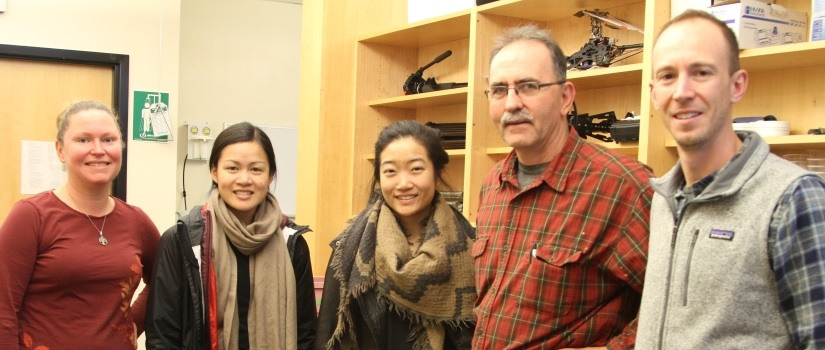January 4, 2017 | Erin Bluvas, bluvase@sc.edu
Robin (Buz) Kloot has been a scientist and self-proclaimed soil health nut for years, but he’s only recently discovered the merits of crowdsourcing as a research funding mechanism. A research associate professor in the Department of Environmental Health Sciences’ (ENHS) SmartState Center for Environmental Nanoscience and Risk (CENR), Kloot is interested in advancing sustainable farming methods (e.g., soil conservation) that benefit farmers, the environment, and public health.
A couple years ago, Kloot was approached by Carl Coleman, a farmer in Dillon, S.C. who shared an interest in healthy soil and had some acreage to spare. The two raised $5,022 using experiment.com, a crowdfunding website that supports scientific research, to study how much fertilizer farmers actually need to grow their crops.
If you follow the soil health revolution, you’ll notice that the drivers of this revolution are farmers—not industry and certainly not researchers. Many of our supporters are farmers, and it's doubtful that we would have found any of this funding through the regular channels.
-Buz Kloot, ENHS/CENR Research Associate Professor
Current land grant fertilizer recommendations for nitrogen, phosphorus and potassium (NPK) were typically developed more than 20 years ago and don’t reflect a number of significant organic and other pools of N,P and K that scientists believe reside in healthy functioning soils. With the no-till revolution that took off 20-30 years ago and the recent cover crop revolution, many soils have come alive and innovative farmers are beginning to question the existing recommendations. In fact, the 41 backers who funded the project were predominantly farmers.
“If you follow the soil health revolution, you’ll notice that the drivers of this revolution are farmers—not industry and certainly not researchers,” says Kloot. “Many of our supporters are farmers, and it's doubtful that we would have found any of this funding through the regular channels.”
Enlisting study design and soil analysis assistance from Clemson University Associate Professor Dara Park, Kloot and Coleman set out to determine how little fertilizer they could use on Coleman’s wheat crops. Their experiment aimed to not only help farmers, who spend more than half their standard crop budgets (up to $190/acre) on commercial fertilizers, but to benefit the environment and the soil as well.
“Soils are living integrated ecosystems and if treated as ecosystems, will provide farmers with services that were previously bought.
-Buz Kloot, ENHS/CENR Research Associate Professor
The researchers believe that healthy soil requires less than 20 percent of the currently used amounts. This decrease would see a corresponding reduction in energy expenditure (e.g., energy content of commercial nitrogen), fertilizer in local waterbodies (up to 90 percent less), and carbon released into the environment (an estimated 2,400/acre per year).
“Soils are living integrated ecosystems and if treated as ecosystems, will provide farmers with services that were previously bought,” says Kloot, explaining their overarching approach.
After completing this initial research, Kloot and Coleman decided to continue the project and to follow the effect of nitrogen and potassium in the soil over three more years. In 2016, the pair raised another $20,199—again through crowdsourcing on experiment.com. This time, they were also able to benefit from the contributing funds program offered by USC’s Office of the Vice President for Research.
With their funding goals met by 67 project backers and the contributing funds program, Kloot and Coleman have expanded their team and research objectives with this two-year project. Their central goal is to see if they can economically grow corn, wheat and soybeans in a healthy soil with lower nitrogen, less (or even no) potassium and lime, and zero phosphorus.
“We hope to use this data to help farmers better understand their systems and help farmers save big on fertilizer,” says Kloot. The continuous development of an integrated, regenerative farming system will decrease use of commercial fertilizers, and Kloot also hopes that this will also lead to better food for consumers while positively impacting the land, the farmer, the environment and, of course, public health.
We hope to use this data to help farmers better understand their systems and help farmers save big on fertilizer.
-Buz Kloot, ENHS/CENR Research Associate Professor
Throughout the projects, the team has noted the critical role of experiment.com in making this research possible. “These remarkable young people have opened another door for researchers to acquire research funding through a crowd funding mechanism,” says Kloot after a recent visit from two experiment.com staff members to USC’s campus (pictured above at far left with graduate student Stacie Gantz (center), Kloot (second to right), and graduate student Gabe Kenne (far right)). In addition to serving as a platform for fundraising, experiment.com also supplies features that allow researchers to engage supporters and update them on project progress.
“One of the more exciting ideas is to make research more real-time and transparent,” says Kloot. “Ours is but a tiny part of their (Experiment.com’s) story, and I believe they have done very well in challenging some of the established research paradigms.”
To follow Kloot and Coleman’s research project and learn more about partnering with experiment.com, visit their project page.
Related:
